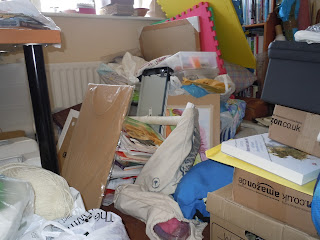Knitted patchwork cushion
I have been asked to run some knitting classes at a local craft shop called Society Rocks and was trying to think of something to inspire a beginners knitting class. I was thinking about how the two main stitches of knit and purl form the basis of so many different patterns and that there are so many variations and possibilities for experimentation. Then I thought about how different pieces could be knitted and joined to form a patchwork of fabric. Of course, when many knitters start their first knitted project they very often knit a long length of fabric, which eventually may become a scarf, but in my experience this can get a little boring and the project is very often left abandoned. So I thought about knitting patches in different colours and stitches, thus enabling the beginner a chance to experiment and make a sort of knitted sampler.
I thought about how these patches could be used on a small project to begin with and came up with the idea of using them on a cushion. I know that knitting gauge can be a bit technical for a beginner, but if the same size needles were used for the patches, and the same weight of yarn throughout, with a little bit of estimation, the patches could be fitted together to make a cover to fit the cushion. I decided to try this for one side of my cushion and used a piece of fabric for the other side. Of course, two sides of patchwork in knitting could have been used. The fabric was a fat quarter of Amy Butler fabric that I had in my stash and it went very well with the bits and pieces of Rowan yarns that I had left over from other knitted projects. These were cashsoft and a cotton glace yarn. The cotton glace I used doubled to obtain a similar thickness to the cashsoft and they all have some cotton in them and therefore have a similar feel. This could also be made using some recycled or vintage fabric on one side and any double knitting yarns on the other.
The patches were made by casting on 20 stitches for the small patches and 40 stitches for the large patch and 60 stitches for the bottom patch. The long patch of 1 x 1 rib stitch had 30 stitches (an extra 10 stitches needed because rib pulls in slightly). I made a cushion of 12" x 12" or 30.5cm x 30.5cm. This same patchwork technique could be used to make larger cushions, a patchwork scarf or blanket and is a great way to use up any leftover yarn.
Patches joined together using mattress stitch. Also good practice for stitching knitted fabric together!
Don't pull up the stitches too tightly or they won't lie flat!
This is how the back of the work looked when I had joined all the patches together.
A piece of fabric cut out the same size as the cushion front, but 1" or 2.5cm added on one side for a hem turning.
These could be joined together using a neat back stitch by hand, but for speed and because I am lazy, I joined them with a sewing machine.
Turn a hem over on one end and sew it down on the wrong side of the fabric.
Now place the right sides of the knitted patchwork fabric and the other fabric together, pin and then sew around the outside, leaving an opening on the side with the turned hem. First of all, I went around the edges with a large zig-zag stitch to hold the layers together. You may need to gently push and pull the knitted fabric into shape with the other fabric square. Then I set the machine to a fairly long stitch length (about 3.5) and sewed around the inside of the zig-zag stitch, again making sure to leave the opening with the hem free.
Turn it out to the right side and poke out the corners.
Sew some large poppers onto the hem of the open side.
Close up of the hand-sewn poppers.
Back view of the cushion.
Voila! a pretty patchwork cushion.
I will talk about stuffing and making your own cushion pads in my next post.



















